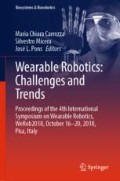Abstract
With the objective of satisfying the technical and functional requirements set for intention detection (ID) algorithm, we investigated suitable strategies to reduce the number of remote units such as inertial measurement units (IMU). The optimization should not affect the ID algorithm, which needs to detect continuous transitions between different locomotion modes such as ground-level walking, walking up and down slopes, climbing/descending stairs, standing up, sitting down, turning and other scenarios of real life. In the developed solution, the number of remote units was reduced from 9 to 4. In order to achieve the same level of ID algorithm performance, the WSA units need to perform almost perfectly. The main innovation is nearly perfect data transfer from remote units to the master unit. This way a package loss below 0.05% of transferred packages is achieved.
This work was supported by the CYBERLEGs Plus Plus project under grant 731931 of the call H2020-ICT-24-2015, and by the Slovenian Research Agency. We would like to thank Filippo Dell’Agnello, Elena Martini, and Andrea Parri from Scuola Superiore Sant’Anna, Pisa, Italy for their contributions.
Access this chapter
Tax calculation will be finalised at checkout
Purchases are for personal use only
References
Lambrecht, B.G., Kazerooni, H.: Design of a semi-active knee prosthesis. In: Proceedings of the IEEE International Conference on Robotics and Automation, Kobe, Japan, pp. 639–645 (2009)
Martinez-Villalpando, E.C., Herr, H.: Agonist-antagonist active knee prosthesis: a preliminary study in level-ground walking. J. Rehabil. Res. Dev. 46(3), 361 (2009)
Au, S.K., Weber, J., Herr, H.: Powered ankle-foot prosthesis improves walking metabolic economy. IEEE Trans. Robot. 25(1), 51–66 (2009)
Pillai, M.V., Kazerooni, H., Hurwich, A.: Design of a semi-active knee-ankle prosthesis. In: Proceedings of the 2011 IEEE International Conference on Robotics and Automation, Shanghai, China, pp. 5293–5300 (2011)
Ambrozic, L.: CYBERLEGs: a user-oriented robotic transfemoral prosthesis with whole-body awareness control. IEEE Robot. Autom. Mag. 21(4), 82–93 (2014)
Goršič, M.: Online phase detection using wearable sensors for walking with a robotic prosthesis. Sensors 14(2), 2776–2794 (2014)
Parri, A.: Whole body awareness for controlling a robotic transfemoral prosthesis. Front. Neurorobotics 11, 25 (2017)
Author information
Authors and Affiliations
Corresponding author
Editor information
Editors and Affiliations
Rights and permissions
Copyright information
© 2019 Springer Nature Switzerland AG
About this paper
Cite this paper
Logar, G., Ivanic, Z., Munih, M. (2019). Wearable Sensory Apparatus Performance While Using Inertial Measurement Units. In: Carrozza, M., Micera, S., Pons, J. (eds) Wearable Robotics: Challenges and Trends. WeRob 2018. Biosystems & Biorobotics, vol 22. Springer, Cham. https://doi.org/10.1007/978-3-030-01887-0_5
Download citation
DOI: https://doi.org/10.1007/978-3-030-01887-0_5
Published:
Publisher Name: Springer, Cham
Print ISBN: 978-3-030-01886-3
Online ISBN: 978-3-030-01887-0
eBook Packages: EngineeringEngineering (R0)

